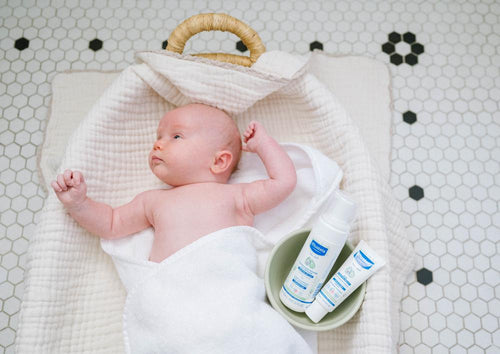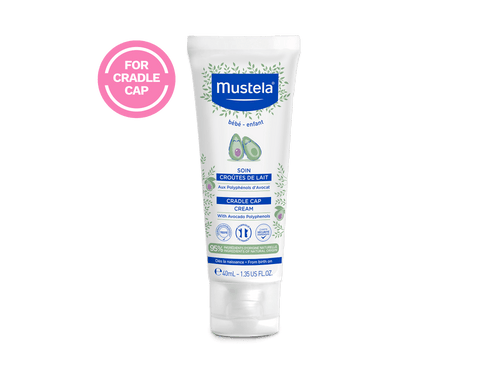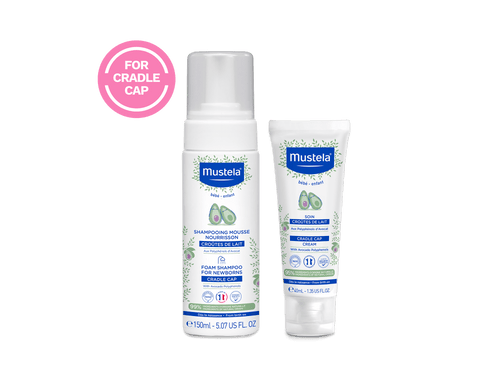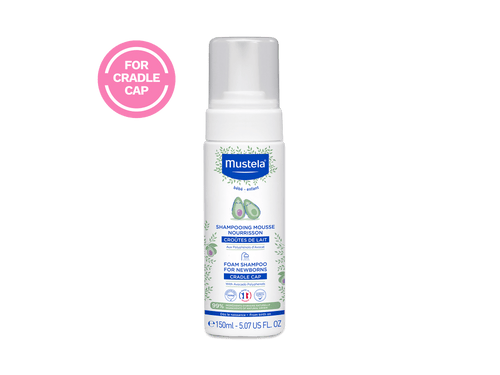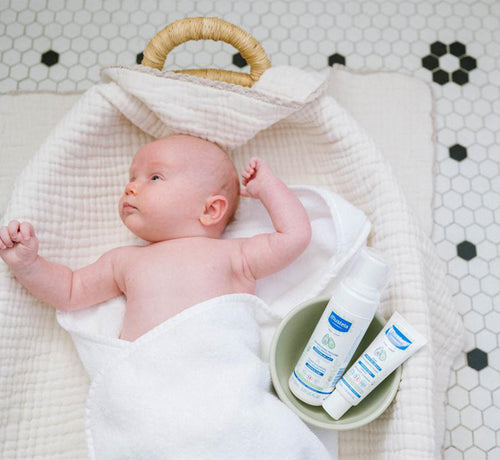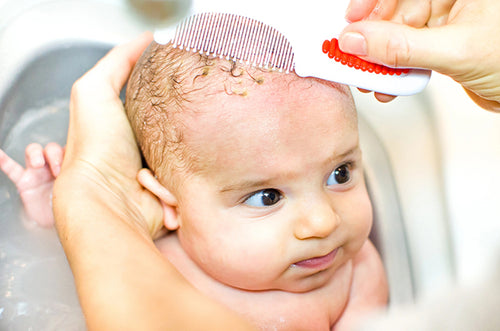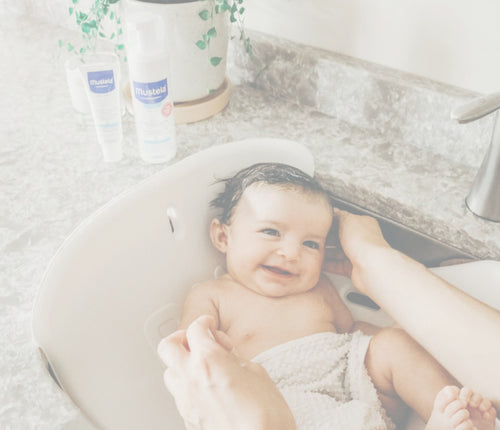If you notice flaky, oily patches of skin on your baby’s scalp, it’s likely cradle cap. This common skin condition affects many infants, often within the first three months of life. And though it’s typically harmless, it can leave you wondering, “How long does cradle cap last?”
We wrote this guide to help you answer that question and provide tips for managing those pesky flakes.
Table Of Contents
- What Is Cradle Cap?
- How Long Does Cradle Cap Last If Untreated?
- How Long Does Cradle Cap Last With Home Treatment?
- How To Treat Cradle Cap
- When To Go To The Doctor
What Is Cradle Cap?
Cradle cap, or infantile seborrheic dermatitis, is a skin condition that often presents as scaly yellow or brown patches on your baby’s scalp. It can also occur on their face, neck, or diaper area.
Approximately 10% of babies develop cradle cap. It most often appears at three months of age, though your little one may experience symptoms earlier or later.
Symptoms
Cradle cap can cause:
- Flakes that feel greasy (as opposed to dry)
- Thick areas of skin
- Scaly eyebrows
- Red patches
- Hair loss in affected areas
- Visible flakes on your baby’s hair
The flaky skin doesn’t usually itch or cause pain. Your baby may not even notice the unusual patches.
Causes
The exact cause of cradle cap isn’t fully understood, but scientists have learned that it’s not related to poor hygiene. It’s also not contagious, so your baby didn’t catch it from anyone and they can’t pass it along to other family members.
Current research suggests that hormonal changes may trigger cradle cap. These hormones — leftover from your baby’s time in the womb or passed along through breastfeeding — cause the sebaceous glands to produce too much oil.
Another possible cause is a type of yeast called Malassezia, which is normally found on the skin. When too much of this yeast is present, it can cause irritation and an overproduction of oil.
Once your baby’s scalp becomes too oily, the skin cells they naturally shed stick together instead of falling off. The build-up of these cells forms the thick, scaly patches associated with cradle cap.
How Long Does Cradle Cap Last If Untreated?
Most babies eventually outgrow cradle cap by their first birthday. Since this condition is generally considered harmless and treatment is cosmetic, some parents choose not to do anything about their baby’s cradle cap.
You may not notice the flaky patches if your little one has enough hair. And if it’s not bothering you or your baby, there’s no harm in waiting for it to go away on its own.
Of course, every decision has its pros and cons. Not treating this condition can save you money on special shampoos and creams. It can also save you a bit of time.
But here are some potential downsides to consider:
- The flakes may become more noticeable as your baby’s hair grows longer (similar to dandruff.)
- The tiny white flakes could be mistaken for lice by well-meaning but misinformed individuals.
- Your baby’s scalp may become itchy and uncomfortable, which could lead to scratching.
- Cradle cap can spread from one part of the body to another.
There is no right or wrong answer, so do what you think is best for your baby.
How Long Does Cradle Cap Last With Home Treatment?
With simple home treatment, most cases of cradle cap disappear in just a few weeks. Prioritizing scalp care can significantly reduce the duration and severity of your baby’s symptoms.
Thankfully, treating this condition isn’t complicated or time-consuming. Let’s look at some effective treatment options.
How To Treat Cradle Cap
Here are some tried-and-true methods for treating cradle cap at home.
Use The Right Products
Your baby has delicate skin, so it’s important to be mindful about what products you use on their scalp.
Opt for gentle, natural, and fragrance-free products specially designed for cradle cap, such as our Foam Shampoo for Newborns and Cradle Cap Cream. When used together, this duo quickly treats the flaky patches.
The formulas are gentle enough to be used on newborns. We use naturally derived ingredients, such as Avocado Polyphenols, to help hydrate the scalp and eliminate cradle cap.
Like our other products, they are backed by scientific research and tested by dermatologists and pediatricians to ensure safety and effectiveness.
Avoid Triggers
Since cradle cap makes your baby’s head feel greasy, you may want to bathe them more frequently. Unfortunately, too much time in the water can dry out their skin.
When they have dry skin, their body’s sebaceous glands kick up oil production to compensate. This can create a vicious cycle and make cradle cap worse.
Instead, bathe your baby no more than once a day and shampoo their hair only two or three times a week.
When bathing your baby, keep these best practices in mind:
- Keep the water lukewarm
- Use mild cleansers
- Limit the bath to 5-10 minutes
- Pat your baby dry with a soft towel
This will keep them clean without further irritating their skin or scalp.
Keep Baby’s Scalp Hydrated
How long does cradle cap last? Not long if you nourish your little one’s scalp with our Cradle Cap Cream.
Once you rub this hydrating cream over the affected areas, let it sit overnight to work its magic on the scales and flakes. In the morning, wash it out. You’ll be amazed at how quickly your baby’s scalp starts to look better.
A clinical study found that 92% of participants agreed that this product quickly eliminates cradle cap.
Brush The Flakes Out

If your baby has a moderate or severe case of cradle cap, you may need to use a soft brush to loosen the flakes. Do this in the bath, as the water can help soften the flakes and make them easier to remove.
Brush in a circular motion, being careful to avoid any areas that are red or irritated. After brushing, rinse your baby’s hair well to remove the loose flakes.
Avoid Picking
While you may be tempted to sit and pick all the flakes off your baby’s scalp, resisting this urge is important. Picking at them can cause irritation, or even an infection.
Remember that your baby’s scalp is delicate. It doesn’t take much pressure with a fingernail to accidentally gouge or scratch their skin.
Instead, focus on keeping your baby’s scalp clean and hydrated with the techniques and products mentioned above. This will help improve the appearance of the cradle cap, making it less tempting to pick.
When To Go To The Doctor
In most cases, your baby’s cradle cap will begin clearing up within a few weeks of starting treatment. However, if your baby’s scalp isn’t improving or is getting worse, it’s time to visit their doctor.
Here are some other reasons to take your baby in for their cradle cap:
- Spreading to other areas of their body
- Becoming an angry red color
- Causing pain or discomfort
- Oozing pus or other signs of infection
And, of course, you’ll want to use your best judgment. Any time you’re worried about your baby’s health, it’s always best to err on the side of caution and get professional advice.
Your doctor can examine your baby’s scalp and determine if it’s cradle cap or another skin condition (such as eczema). Then, they can create a personalized treatment plan.
Cradle Cap, Begone!

How long does cradle cap last? It depends on whether or not you decide to treat it. Without treatment, it may stick around until your baby’s first birthday. But with consistent care, most cases will clear up within a few weeks.
If you’re ready to say goodbye to cradle cap, remember these tips:
- Apply Cradle Cap Cream before bed
- Wash out the following day with Foam Shampoo for Newborns
- Use a brush to loosen and remove flakes
- Keep your fingers off of the scalp
You can help your baby’s cradle cap disappear for good with a little patience and extra TLC with Mustela products. And that’s something worth celebrating!


